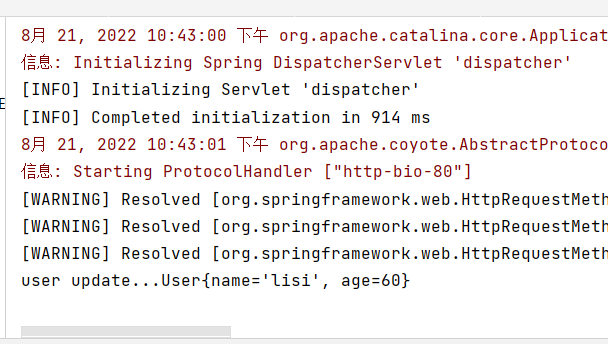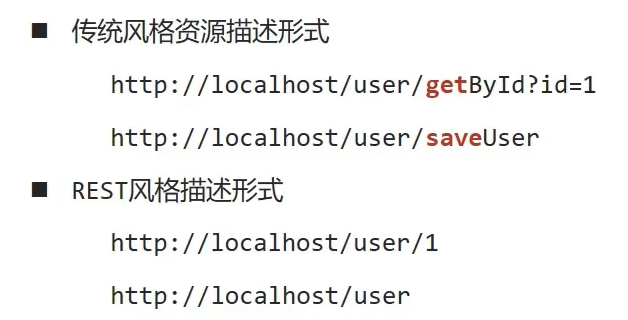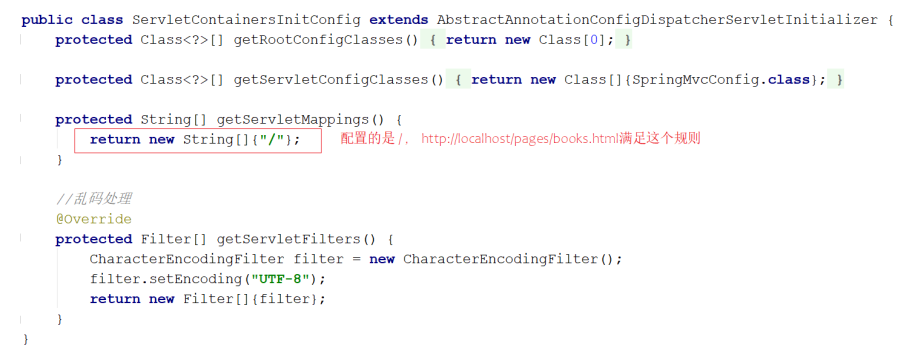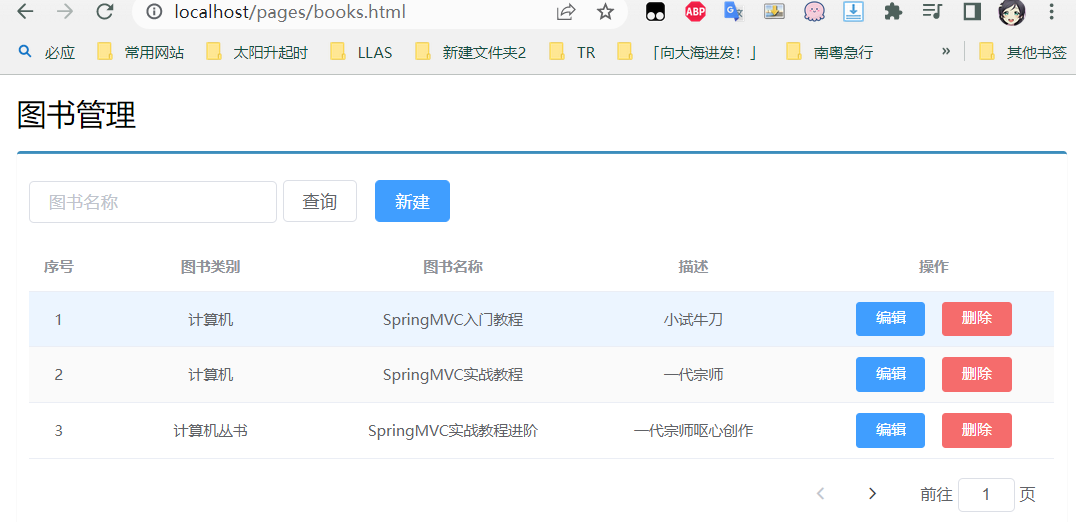REST风格
其他springMvc笔记
SpringMVC _ 起步(http://mxzfun.xyz/index.php/archives/553/)
springMvc _ 请求与响应(http://mxzfun.xyz/index.php/archives/557)
SpringMVC _ REST风格(http://mxzfun.xyz/index.php/archives/558)
SpringMVC _ SSM整合、拦截器(http://mxzfun.xyz/index.php/archives/562/)
三、REST风格
3.1 REST简介
REST (Representational State Transfer),表现形式状态转换。
优点:
- 隐藏资源的访问行为,无法通过地址得知对资源是何种操作;
- 书写简化。
按照REST风格访问资源时使用行为动作区分对资源进行了何种操作:
- 根据REST风格对资源进行访问称为RESTful。
注意事项:
- 上述行为是约定方式,约定不是规范,可以打破,所以称REST风格,而不是REST规范。
- 描述模块的名称通常使用复数,也就是加s的格式描述,表示此类资源,而非单个资源,例如:users、books、account....
3.2 RESTful入门案例
(1)新增
- 将请求路径更改为
/users - 访问该方法使用 POST: http://localhost/users
- 使用method属性限定该方法的访问方式为POST。
- (如果发送的不是POST请求,比如发送GET请求,则会报错)
public class UserController {
//设置当前请求方法为POST,表示REST风格中的添加操作
@RequestMapping(value = "/users",method = RequestMethod.POST)
@ResponseBody
public String save(){
System.out.println("user save...");
return "{'module':'user save'}";
}
}(2)删除
- 将请求路径更改为
/users - 访问该方法使用 DELETE: http://localhost/users
针对RESTful的开发,如何携带数据参数?
传递路径参数
- 前端发送请求的时候使用: http://localhost/users/1 ,路径中的1就是我们想要传递的参数。
后端获取参数,需要做如下修改:
- 修改
@RequestMapping的value属性,将其中修改为/users/{id},目的是和路径匹配。 - 在方法的形参前添加
@PathVariable注解。
- 修改
@Controller
public class UserController {
//设置当前请求方法为DELETE,表示REST风格中的删除操作
//@PathVariable注解用于设置路径变量(路径参数),要求路径上设置对应的占位符,并且占位符名称与方法形参名称相同
@RequestMapping(value = "/users/{id}",method = RequestMethod.DELETE)
@ResponseBody
public String delete(@PathVariable Integer id){
System.out.println("user delete..." + id);
return "{'module':'user delete'}";
}
}如果方法形参的名称和路径{}中的值不一致,该怎么办?
如果有多个参数需要传递该如何编写?
- 前端发送请求的时候使用: http://localhost/users/1/tom ,路径中的1和tom就是我们想要传递的两个参数。
- 后端获取参数,需要做如下修改:
@Controller
public class UserController {
//设置当前请求方法为DELETE,表示REST风格中的删除操作
@RequestMapping(value = "/users/{id}/{name}",method =
RequestMethod.DELETE)
@ResponseBody
public String delete(@PathVariable Integer id,@PathVariable String name)
{
System.out.println("user delete..." + id+","+name);
return "{'module':'user delete'}";
}
}(3)修改
- 将请求路径更改为
/users - 访问该方法使用PUT: http://localhost/users
- 访问并携带参数:


@Controller
public class UserController {
//设置当前请求方法为PUT,表示REST风格中的修改操作
@RequestMapping(value = "/users",method = RequestMethod.PUT)
@ResponseBody
public String update(@RequestBody User user){
System.out.println("user update..."+user);
return "{'module':'user update'}";
}
}(4)根据ID查询
- 将请求路径更改为
/users - 访问该方法使用GET: http://localhost/users/450
@Controller
public class UserController {
//设置当前请求方法为GET,表示REST风格中的查询操作
//@PathVariable注解用于设置路径变量(路径参数),要求路径上设置对应的占位符,并且占位符名称与方法形参名称相同
@RequestMapping(value = "/users/{id}" ,method = RequestMethod.GET)
@ResponseBody
public String getById(@PathVariable Integer id){
System.out.println("user getById..."+id);
return "{'module':'user getById'}";
}
}(5)查询所有
- 将请求路径更改为
/users - 访问该方法使用GET: http://localhost/users
@Controller
public class UserController {
//设置当前请求方法为GET,表示REST风格中的查询操作
@RequestMapping(value = "/users",method = RequestMethod.GET)
@ResponseBody
public String getAll(){
System.out.println("user getAll...");
return "{'module':'user getAll'}";
}
}(6)总结
设定Http请求动作(动词)
@RequestMapping(value="",method = RequestMethod.POST|GET|PUT|DELETE)设定请求参数(路径变量)
@RequestMapping(value="/users/{id}",method = RequestMethod.DELETE)
@ReponseBody
public String delete(@PathVariable Integer id){
}(7)知识点 —— @PathVariable
(8)@RequestBody、@RequestParam、@PathVariable 注解之间的区别和应用
区别
- @RequestParam用于接收url地址传参或表单传参。
- @RequestBody用于接收json数据。
- @PathVariable用于接收路径参数,使用
{参数名称}描述路径参数。
应用
- 后期开发中,发送请求参数超过1个时,以json格式为主,@RequestBody应用较广;
- 如果发送非json格式数据,选用@RequestParam接收请求参数;
- 采用RESTful进行开发,当参数数量较少时,例如1个,可以采用@PathVariable接收请求路 径变量,通常用于传递id值。
3.3 REST快速开发
- 每个方法的@RequestMapping注解中都定义了访问路径/books,重复性太高。
- 每个方法的@RequestMapping注解中都要使用method属性定义请求方式,重复性太高。
- 每个方法响应json都需要加上@ResponseBody注解,重复性太高。
(1)解决方案
//@Controller
//@ResponseBody配置在类上可以简化配置,表示设置当前每个方法的返回值都作为响应体
//@ResponseBody
@RestController //使用@RestController注解替换@Controller与@ResponseBody注解,简化书写
@RequestMapping("/books")
public class BookController {
// @RequestMapping( method = RequestMethod.POST)
@PostMapping //使用@PostMapping简化Post请求方法对应的映射配置
public String save(@RequestBody Book book){
System.out.println("book save..." + book);
return "{'module':'book save'}";
}
// @RequestMapping(value = "/{id}" ,method = RequestMethod.DELETE)
@DeleteMapping("/{id}") //使用@DeleteMapping简化DELETE请求方法对应的映射配置
public String delete(@PathVariable Integer id){
System.out.println("book delete..." + id);
return "{'module':'book delete'}";
}
// @RequestMapping(method = RequestMethod.PUT)
@PutMapping //使用@PutMapping简化Put请求方法对应的映射配置
public String update(@RequestBody Book book){
System.out.println("book update..."+book);
return "{'module':'book update'}";
}
// @RequestMapping(value = "/{id}" ,method = RequestMethod.GET)
@GetMapping("/{id}") //使用@GetMapping简化GET请求方法对应的映射配置
public String getById(@PathVariable Integer id){
System.out.println("book getById..."+id);
return "{'module':'book getById'}";
}
// @RequestMapping(method = RequestMethod.GET)
@GetMapping //使用@GetMapping简化GET请求方法对应的映射配置
public String getAll(){
System.out.println("book getAll...");
return "{'module':'book getAll'}";
}
}- 每个方法的@RequestMapping注解中都定义了访问路径/books,重复性太高 —— 解决方案
* 将@RequestMapping提到类上面,用来定义所有方法共同的访问路径。- 每个方法的@RequestMapping注解中都要使用method属性定义请求方式,重复性太高 —— 解决方案
* 使用@GetMapping @PostMapping @PutMapping @DeleteMapping代替- 每个方法响应json都需要加上@ResponseBody注解,重复性太高 —— 解决方案
* 将ResponseBody提到类上面,让所有的方法都有@ResponseBody的功能;
* 使用@RestController注解替换@Controller与@ResponseBody注解,简化书写。(2)知识点1 —— @RestController
(3)知识点2 —— @GetMapping、@PostMapping、@PutMapping、@DeleteMapping
3.4 案例:基于RESTful页面数据交互
(1)环境准备
pom.xml
<dependencies>
<dependency>
<groupId>javax.servlet</groupId>
<artifactId>javax.servlet-api</artifactId>
<version>3.1.0</version>
<scope>provided</scope>
</dependency>
<dependency>
<groupId>org.springframework</groupId>
<artifactId>spring-webmvc</artifactId>
<version>5.2.10.RELEASE</version>
</dependency>
<dependency>
<groupId>com.fasterxml.jackson.core</groupId>
<artifactId>jackson-databind</artifactId>
<version>2.9.0</version>
</dependency>
</dependencies>
<build>
<plugins>
<plugin>
<groupId>org.apache.tomcat.maven</groupId>
<artifactId>tomcat7-maven-plugin</artifactId>
<version>2.1</version>
<configuration>
<port>80</port>
<path>/</path>
</configuration>
</plugin>
</plugins>
</build>配置类(ServletContainersInitConfig、SpringMvcConfig)
public class ServletContainersInitConfig extends
AbstractAnnotationConfigDispatcherServletInitializer {
protected Class<?>[] getRootConfigClasses() {
return new Class[0];
}
protected Class<?>[] getServletConfigClasses() {
return new Class[]{SpringMvcConfig.class};
}
protected String[] getServletMappings() {
return new String[]{"/"};
}
//乱码处理
@Override
protected Filter[] getServletFilters() {
CharacterEncodingFilter filter = new CharacterEncodingFilter();
filter.setEncoding("UTF-8");
return new Filter[]{filter};
}
}@Configuration
@ComponentScan("com.li")
//开启json数据类型自动转换
@EnableWebMvc
public class SpringMvcConfig {
}Controller(BookController)
@Controller
public class BookController {
}模型类Book
public class Book {
public Integer getId() {
return id;
}
public void setId(Integer id) {
this.id = id;
}
public String getType() {
return type;
}
public void setType(String type) {
this.type = type;
}
public String getName() {
return name;
}
public void setName(String name) {
this.name = name;
}
public String getDescription() {
return description;
}
public void setDescription(String description) {
this.description = description;
}
private Integer id;
private String type;
private String name;
private String description;
}(2)后台接口开发
编写Controller类并使用RESTful进行配置
@RestController
@RequestMapping("/books")
public class BookController {
@PostMapping
public String save(@RequestBody Book book){
System.out.println("book!!!!!!!!"+book);
return "{'module':'book save success'}";
}
@GetMapping
public List<Book> getAll(){
System.out.println("book - run");
List<Book> bookList = new ArrayList<Book>();
Book book1 = new Book();
book1.setType("计算机");
book1.setName("SpringMVC入门教程");
book1.setDescription("小试牛刀");
bookList.add(book1);
Book book2 = new Book();
book2.setType("计算机");
book2.setName("SpringMVC实战教程");
book2.setDescription("一代宗师");
bookList.add(book2);
Book book3 = new Book();
book3.setType("计算机丛书");
book3.setName("SpringMVC实战教程进阶");
book3.setDescription("一代宗师呕心创作");
bookList.add(book3);
return bookList;
}
}postman测试
{
"type":"计算机丛书",
"name":"SpringMVC终极开发",
"description":"这是一本好书"
}(3)页面访问处理
- 一开始无法直接访问/books.html。为什么?
- 因为SpringMVC拦截了静态资源,根据/pages/books.html去controller找对应的方法,找不到所以会报404的错误。
SpringMVC为什么会拦截静态资源呢?
解决方案
- SpringMVC需要将静态资源进行放行。
- 新建SpringMvcSupport类,继承WebMvcConfigurationSupport。
@Configuration
public class SpringMvcSupport extends WebMvcConfigurationSupport {
//设置静态资源访问过滤,当前类需要设置为配置类,并被扫描加载
@Override
protected void addResourceHandlers(ResourceHandlerRegistry registry) {
//当访问/pages/????时候,从/pages目录下查找内容
registry.addResourceHandler("/pages/**").addResourceLocations("/pages/");
registry.addResourceHandler("/js/**").addResourceLocations("/js/");
registry.addResourceHandler("/css/**").addResourceLocations("/css/");
registry.addResourceHandler("/plugins/**").addResourceLocations("/plugins/")
;
}
}- 该配置类是在config目录下,SpringMVC扫描的是controller包,所以该配置类还未生效,要想生效需要将SpringMvcConfig配置类进行修改。
@ComponentScan("com.li")变了,原来是@ComponentScan("com.li.controller");也可以是@ComponentScan({"com.li.controller","com.li.config"})。
@Configuration
@ComponentScan("com.li")
//@ComponentScan({"com.li.controller","com.li.config"})
//开启json数据类型自动转换
@EnableWebMvc
public class SpringMvcConfig {
}修改books.html页面
<!DOCTYPE html>
<html>
<head>
<!-- 页面meta -->
<meta charset="utf-8">
<title>SpringMVC案例</title>
<!-- 引入样式 -->
<link rel="stylesheet" href="../plugins/elementui/index.css">
<link rel="stylesheet" href="../plugins/font-awesome/css/font-awesome.min.css">
<link rel="stylesheet" href="../css/style.css">
</head>
<body class="hold-transition">
<div id="app">
<div class="content-header">
<h1>图书管理</h1>
</div>
<div class="app-container">
<div class="box">
<div class="filter-container">
<el-input placeholder="图书名称" style="width: 200px;" class="filter-item"></el-input>
<el-button class="dalfBut">查询</el-button>
<el-button type="primary" class="butT" @click="openSave()">新建</el-button>
</div>
<el-table size="small" current-row-key="id" :data="dataList" stripe highlight-current-row>
<el-table-column type="index" align="center" label="序号"></el-table-column>
<el-table-column prop="type" label="图书类别" align="center"></el-table-column>
<el-table-column prop="name" label="图书名称" align="center"></el-table-column>
<el-table-column prop="description" label="描述" align="center"></el-table-column>
<el-table-column label="操作" align="center">
<template slot-scope="scope">
<el-button type="primary" size="mini">编辑</el-button>
<el-button size="mini" type="danger">删除</el-button>
</template>
</el-table-column>
</el-table>
<div class="pagination-container">
<el-pagination
class="pagiantion"
@current-change="handleCurrentChange"
:current-page="pagination.currentPage"
:page-size="pagination.pageSize"
layout="total, prev, pager, next, jumper"
:total="pagination.total">
</el-pagination>
</div>
<!-- 新增标签弹层 -->
<div class="add-form">
<el-dialog title="新增图书" :visible.sync="dialogFormVisible">
<el-form ref="dataAddForm" :model="formData" :rules="rules" label-position="right" label-width="100px">
<el-row>
<el-col :span="12">
<el-form-item label="图书类别" prop="type">
<el-input v-model="formData.type"/>
</el-form-item>
</el-col>
<el-col :span="12">
<el-form-item label="图书名称" prop="name">
<el-input v-model="formData.name"/>
</el-form-item>
</el-col>
</el-row>
<el-row>
<el-col :span="24">
<el-form-item label="描述">
<el-input v-model="formData.description" type="textarea"></el-input>
</el-form-item>
</el-col>
</el-row>
</el-form>
<div slot="footer" class="dialog-footer">
<el-button @click="dialogFormVisible = false">取消</el-button>
<el-button type="primary" @click="saveBook()">确定</el-button>
</div>
</el-dialog>
</div>
</div>
</div>
</div>
</body>
<!-- 引入组件库 -->
<script src="../js/vue.js"></script>
<script src="../plugins/elementui/index.js"></script>
<script type="text/javascript" src="../js/jquery.min.js"></script>
<script src="../js/axios-0.18.0.js"></script>
<script>
var vue = new Vue({
el: '#app',
data:{
dataList: [],//当前页要展示的分页列表数据
formData: {},//表单数据
dialogFormVisible: false,//增加表单是否可见
dialogFormVisible4Edit:false,//编辑表单是否可见
pagination: {},//分页模型数据,暂时弃用
},
//钩子函数,VUE对象初始化完成后自动执行
created() {
this.getAll();
},
methods: {
// 重置表单
resetForm() {
//清空输入框
this.formData = {};
},
// 弹出添加窗口
openSave() {
this.dialogFormVisible = true;
this.resetForm();
},
//添加
saveBook () {
axios.post("/books",this.formData).then((res)=>{
});
},
//主页列表查询
getAll() {
axios.get("/books").then((res)=>{
this.dataList = res.data;
});
},
}
})
</script>
</html>








Comments | NOTHING